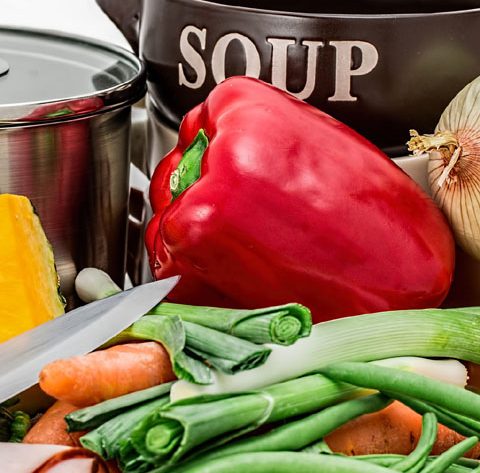Here are 30+ meal ideas for meat eaters that may support autoimmune health, according to a mixture of foods that several doctors have used to help reverse autoimmune disease. These meal ideas eliminate most inflammatory and difficult-to-digest foods, and are mainly gluten-free, dairy-free, soy-free, and have no added sugar. They also limit grains, legumes, nuts, eggs, nightshades, and seeds. Note: more information on where the diet idea came from can be found on my other article called: Examples Of People Who Have Reversed Their Autoimmune Disease.
- Grilled salmon with roasted vegetables
- Grass-fed beef burgers with sweet potato fries (Either Gluten-Free buns or bunless)
- Quinoa bowl with black beans and avocado (as long as the beans are soaked properly – see bottom of page)
- Grilled Organic chicken with steamed broccoli
- Zucchini noodles with “nomato sauce” and gluten-free meatballs
- Cauliflower rice stir-fry with fish and veggies
- Beef or turkey chili with no beans (if tomatoes are well-tolerated
- Roasted root vegetables with organic chicken
- Grass-fed steak with a side salad
- Slow-cooked grass-fed beef stew with vegetables
- Turkey and vegetable soup
- Grilled chicken skewers with a side salad
- Cauliflower pizza with dairy-free cheese and veggies (no tomato, no soy)
- Grilled fish with roasted asparagus
- Stuffed bell peppers with grass-fed beef and veggies
- Chicken lettuce wraps with veggies and avocado
- Homemade turkey meatballs with zucchini noodles
- Broiled salmon with roasted Brussels sprouts (homemade aioli optional)
- Chicken fajitas with guacamole and cucumber “salsa”
- Vegetable stir-fry with grass-fed beef
- Grass-fed beef and vegetable kebabs
- Grilled chicken breast with roasted sweet potato
- Spaghetti squash with meat sauce (coconut milk based, no tomato)
- Chicken and vegetable curry with cauliflower rice
- Homemade vegetable soup with organic chicken
- Turkey lettuce wraps with avocado and veggies
- Vegetable omelet with grass-fed beef or turkey (only if eggs don’t irritate you)
- Roasted chicken with roasted vegetables
- Quinoa salad with roasted veggies and chicken
- Grilled fish tacos with avocado
- Grass-fed beef gluten-free meatloaf with roasted vegetables
- Vegetable and chicken or turkey stir-fry
- Spicy grass-fed beef lettuce wraps with veggies and avocado
Why Soak Beans?
If you are going to consume beans, I recommend soaking them according to how the book Nourishing Traditions mentions.
The book “Nourishing Traditions” recommends soaking beans as part of its overall approach to traditional food preparation. This practice is based on the idea that soaking beans before cooking can make them more digestible and nutritious.
Beans, like many other grains and legumes, contain compounds called phytates that can interfere with the absorption of certain nutrients in the body, such as iron, zinc, and calcium. Soaking beans in water with a small amount of an acidic medium, such as lemon juice or vinegar, can help to break down these phytates and make these nutrients more available for the body to absorb.
Soaking beans can also help to reduce the levels of certain anti-nutrients, such as lectins and tannins, which can cause digestive issues in some people. Additionally, soaking beans can help to soften them, reducing cooking time and making them easier to digest.
Overall, the practice of soaking beans is seen as a way to make this nutritious and protein-rich food more accessible and beneficial for the body. However, it is important to note that there is some debate over the effectiveness of soaking beans, and some studies have shown mixed results. As with any dietary practice, it is important to consult with a healthcare professional before making significant changes to your diet.
According to “Nourishing Traditions,” the best way to soak beans is as follows:
- Rinse the beans thoroughly in a colander under running water.
- Place the beans in a large bowl and cover them with warm water. The water should be about two to three inches above the level of the beans.
- Add an acidic medium to the water, such as a tablespoon of apple cider vinegar, lemon juice, or whey from strained yogurt. This helps to break down the phytic acid in the beans.
- Cover the bowl with a clean cloth and let the beans soak at room temperature for at least 12 hours or up to 24 hours. The longer soaking time can result in more tender beans.
- After soaking, drain the beans and rinse them thoroughly before cooking.
It’s important to note that the soaking time and the amount of acidic medium used may vary depending on the type and age of the beans. For example, older beans may require longer soaking times or more acidic medium to break down the phytic acid. It’s always a good idea to experiment and adjust the soaking method to find what works best for you.
Final Thoughts
In conclusion, incorporating meals that are rich in anti-inflammatory ingredients and nutrients can provide relief to individuals suffering from autoimmune disorders. By including a variety of whole foods, such as fruits, vegetables, nuts, and seeds, in your diet, you can help support your immune system and reduce inflammation. Additionally, by avoiding processed and inflammatory foods, you can further improve your health and manage your symptoms. Overall, making small changes to your diet can have a significant impact on your overall well-being, and these meal ideas can be a great starting point in managing autoimmune disorders. Remember to always consult with a healthcare professional for personalized dietary advice tailored to your specific condition.



